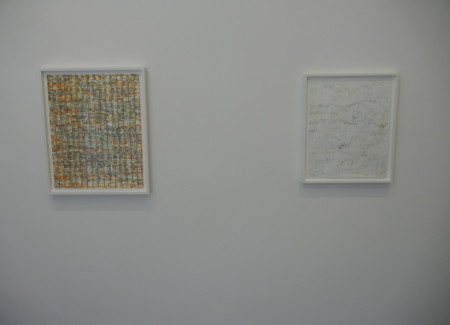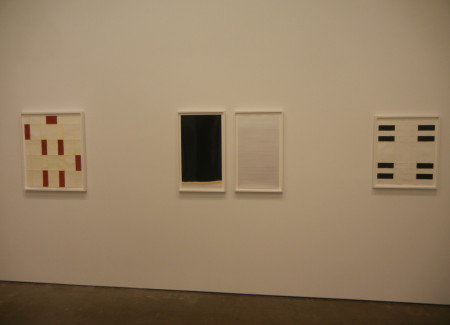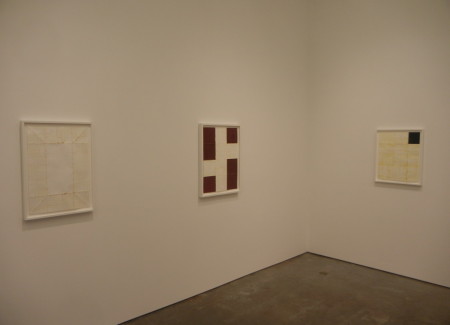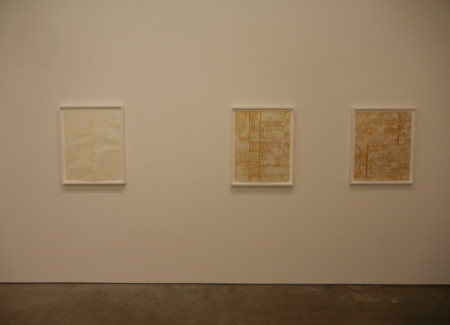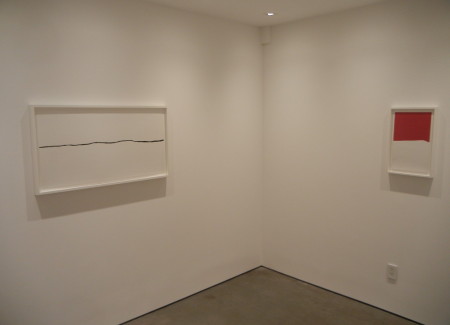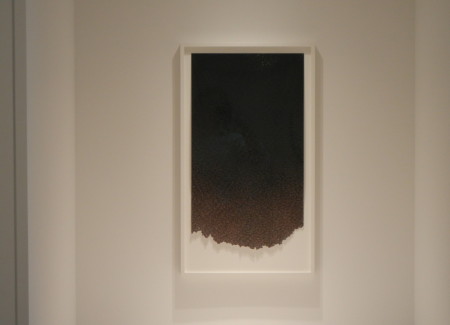JTF (just the facts): A total of 33 color photographs, framed in white and unmatted, and hung against white walls in the East and West galleries and the smaller viewing room in between. All of the works are unique chromogenic prints, which have been alternately folded, burned, scraped, embossed, punctured, and subjected to other processes. The works were made in 2013 and 2014, and range in size from roughly 11×9 to 21×40 (or reverse). (Installation shots below.)
Comments/Context: Much of the process-oriented abstract photography that we’ve seen of late is fundamentally an additive exercise – it’s about starting with a blank sheet of light sensitive paper and then adding gesture, texture, color, rephotographed or photogrammed image fragments, and other innovative elements via filters, chemicals, and techniques (in the darkroom and out), often in a broader effort to explore the boundaries of abstraction. Marco Breuer’s new work goes against this prevailing flow, reversing the activity of image making into an actively subtractive process, excavating his compositions out from the miniscule layers of dyes that make up a photographic emulsion. His new pictures go further than ever before in this incremental taking away process, bringing him all the way back to the original whiteness of the underlying paper.
This show gathers together three new bodies of work all revolving around this elemental removal concept. The first is a direct progression from gridded works seen in his previous show (in 2012, here), where the paper was folded into an array of rectangles. In those works, Breuer started with exposed black paper and scraped away the surface to reveal gestural brown and orange colors underneath. What’s new here is that he has now gone deeper, starting with similar grids, but removing more and more emulsion to create compositions that are now fully yellow, some even becoming an ethereal white, almost like an Agnes Martin painting. The same jagged grooves and scratches are here, as are the jittery seismographic squiggles and the tiny rectangle by rectangle gestures, but he’s extended his earlier ideas further, stripping away more layers to create a lighter palette.
These geometric folds seem to have led Breuer to thinking about abstraction in three dimensions, as a second group of works extend the original grid into new blockier forms with harder edges. The folds are now deeper and more obvious, as though the paper had been used to carefully wrap a brick, creating flattened squares and rectangles that seem to imply origami-like step-by-step creation. Starting again with black or red exposed paper, Breuer has meticulously removed all of the color in certain blocks, creating bold, high contrast abstractions that recall Judd boxes, or Newman zips, or Flavin lights, or unbalanced Mondrian squares. Up close, the white areas are full of gestural swoops and scrapes in faint yellow, a reminder that all of the color has been painstakingly and personally removed.
A third group of works have a different feeling of subtraction, implying a kind of pulling or peeling rather than rough scratching. Wavy lines like horizons are all that remain of the red or black that once covered these pictures (a revelation of craftsmanship I must say), the tiny embossed dots a clue that the pigment used to reside there; they look a little like Alison Rossiter pours, but are in fact almost the opposite. Works made on vertical strips of Duratrans (a transparent film) turn the compositions into scrolls, where Breuer’s removal ultimately reaches clear silvery transparency instead of white paper. One work has been stretched to the breaking point, where the emulsion has literally broken down into colored dots, becoming a lacy, hole-filled jagged edge that is gracefully delicate.
While in a certain way it is hard to imagine that there is much inherent depth to a photographic emulsion, Breuer’s new pictures absolutely feel like he has dug much deeper than in previous works, getting all the way to the fundamental “bottom” of the medium (perhaps the Zero Base of the show’s title). Surface erasure and “drawing” have given way to wholesale removal, leading to much more physical, sculptural forms. After several decades of experimentation, instead of repeating himself, Breuer continues to find new ways to strip down photography and probe its foundations. Compared to earlier his gunshots and turntable spins, these new works feel more back to basics elemental.
Collector’s POV: The works in this show range in price from $9000 to $30000 based on size. Breuer’s work has only an intermittent secondary market history, so gallery retail remains the best option for those collectors interested in following up. This is particularly true because all of Breuer’s works are unique, the best ones tending to go fast and stay off the market.


